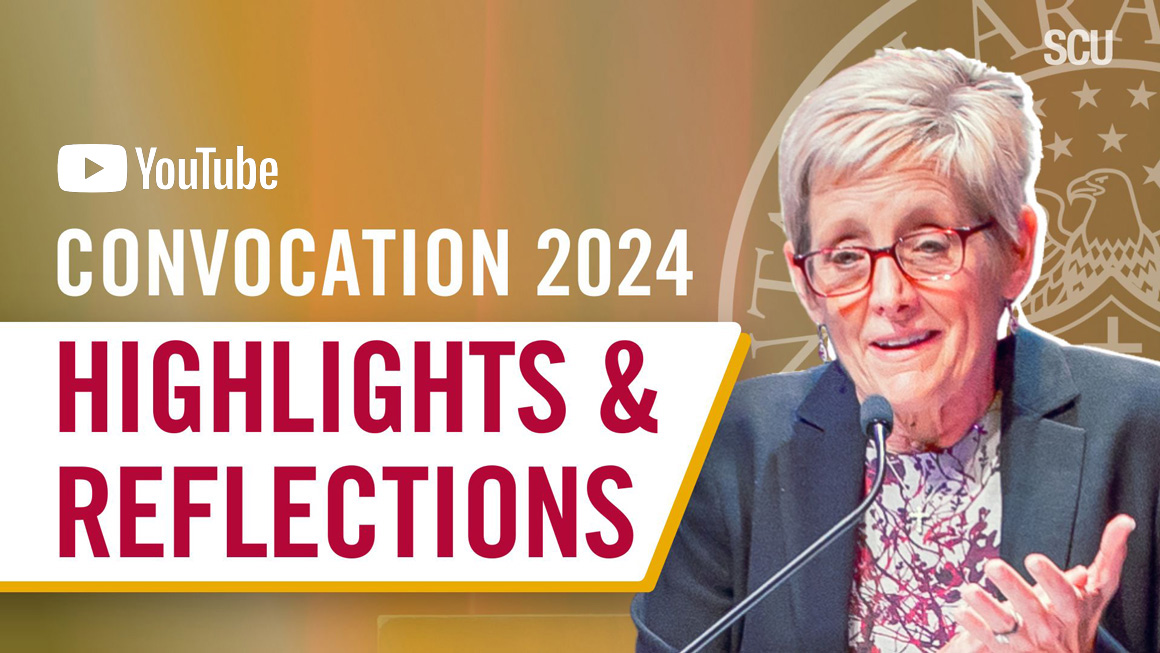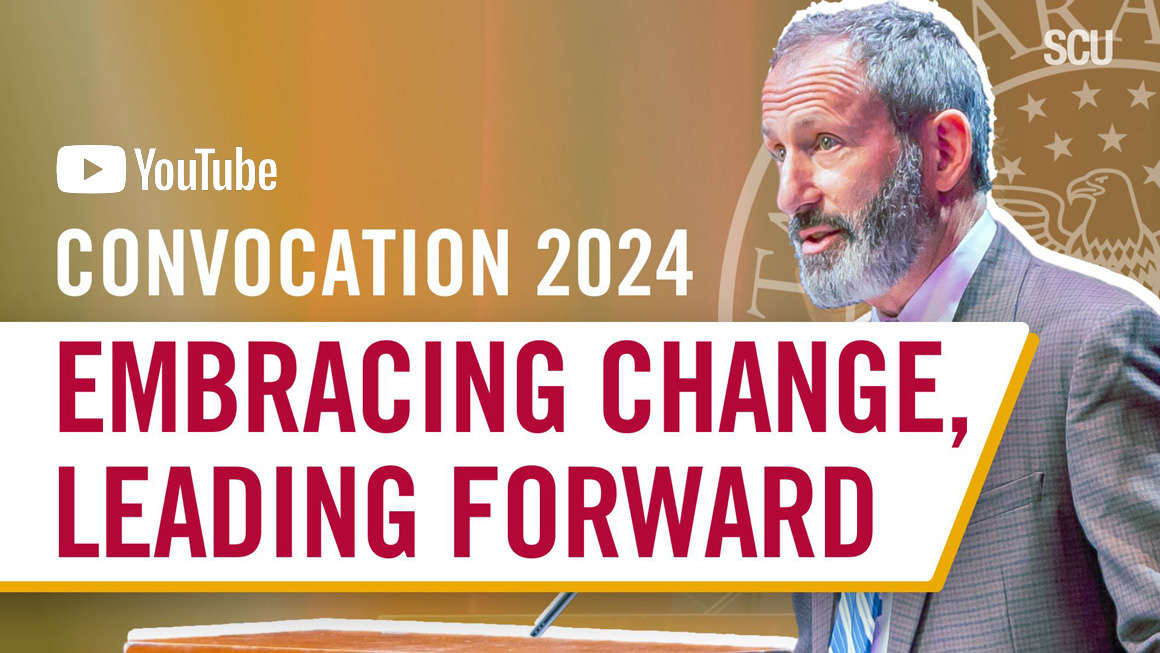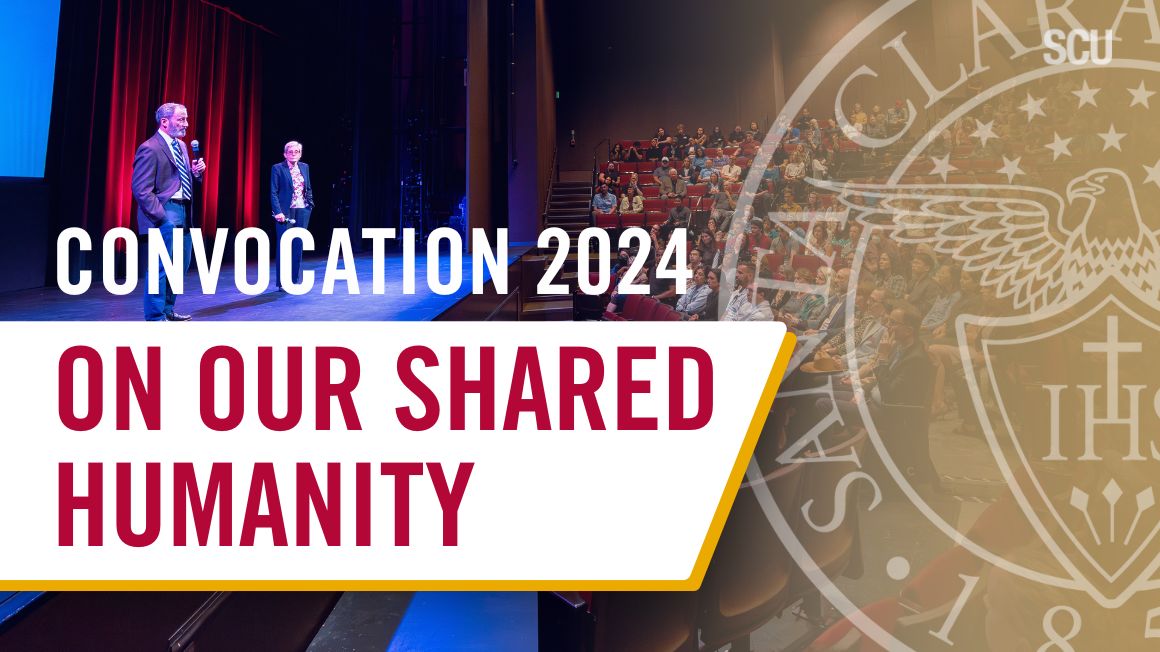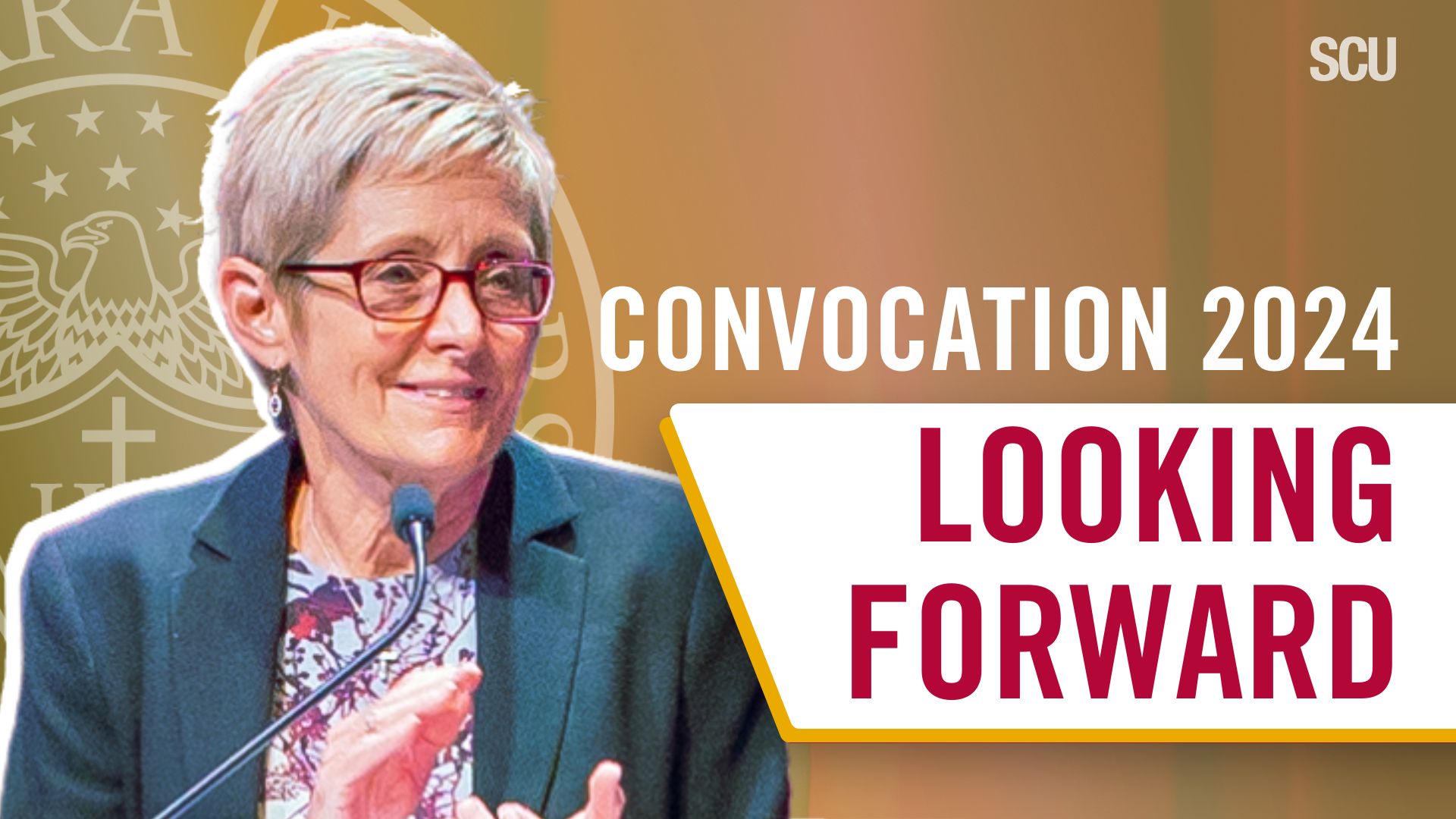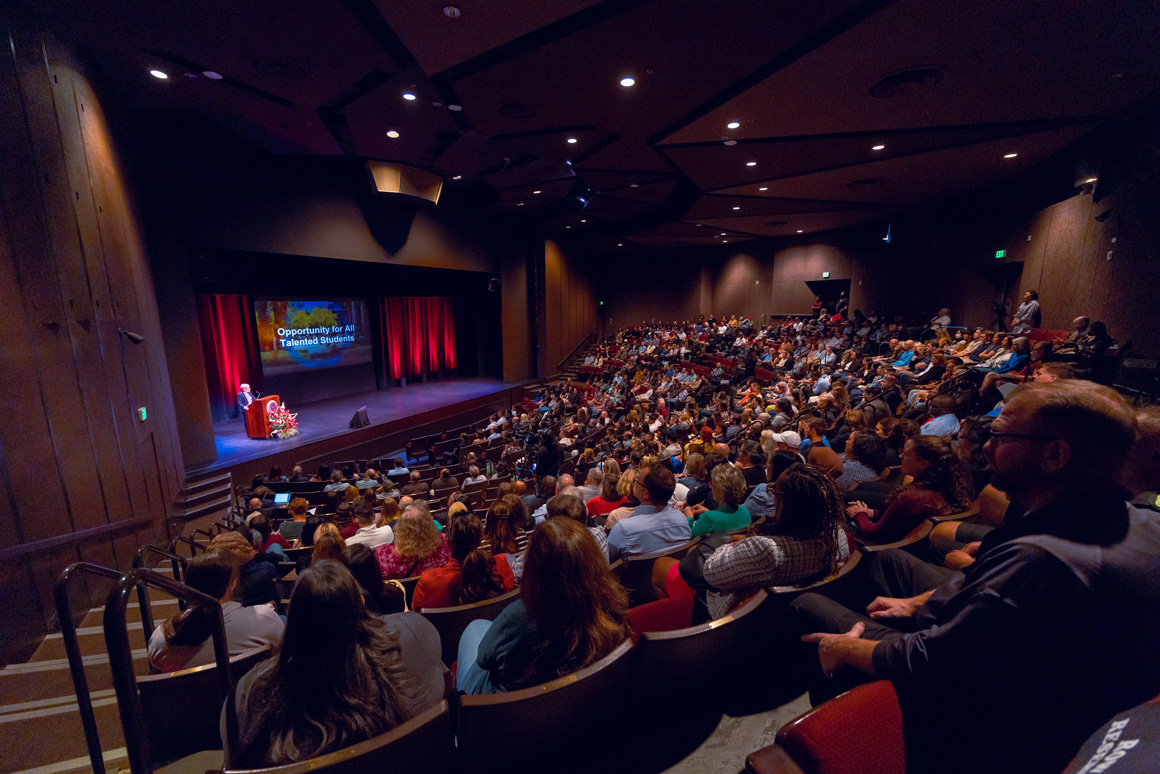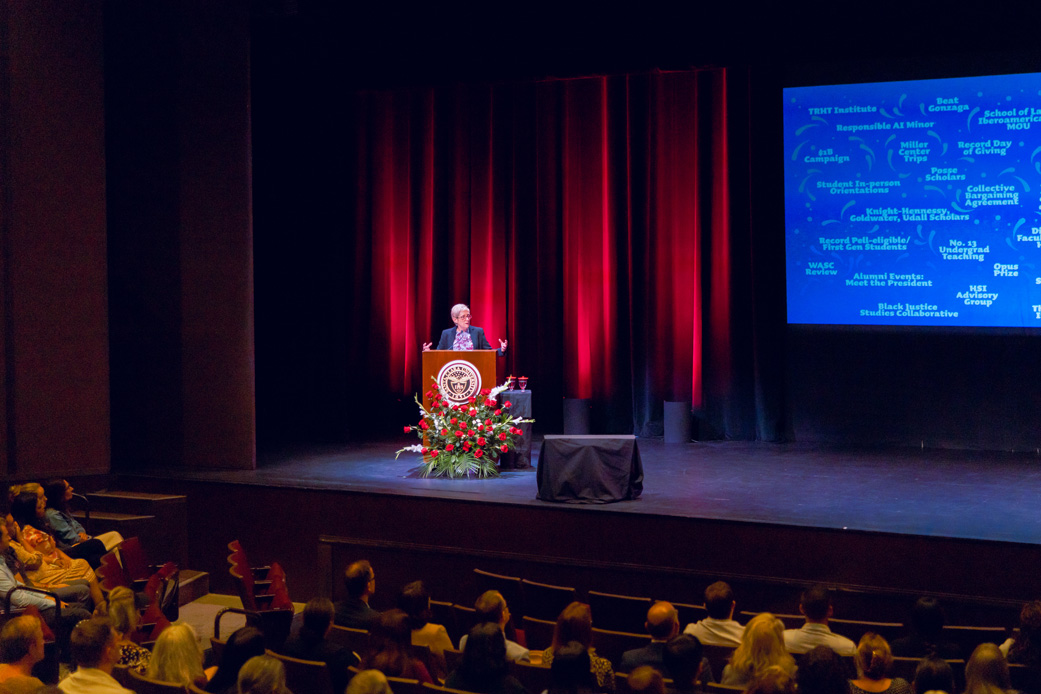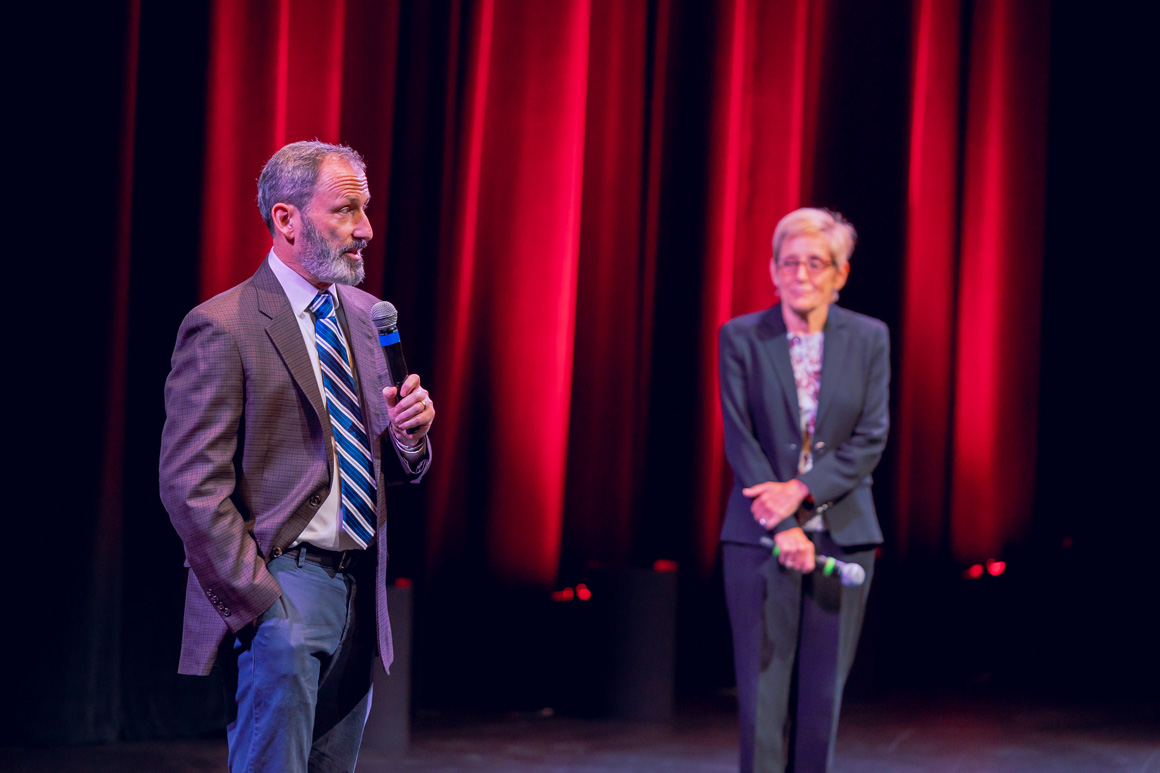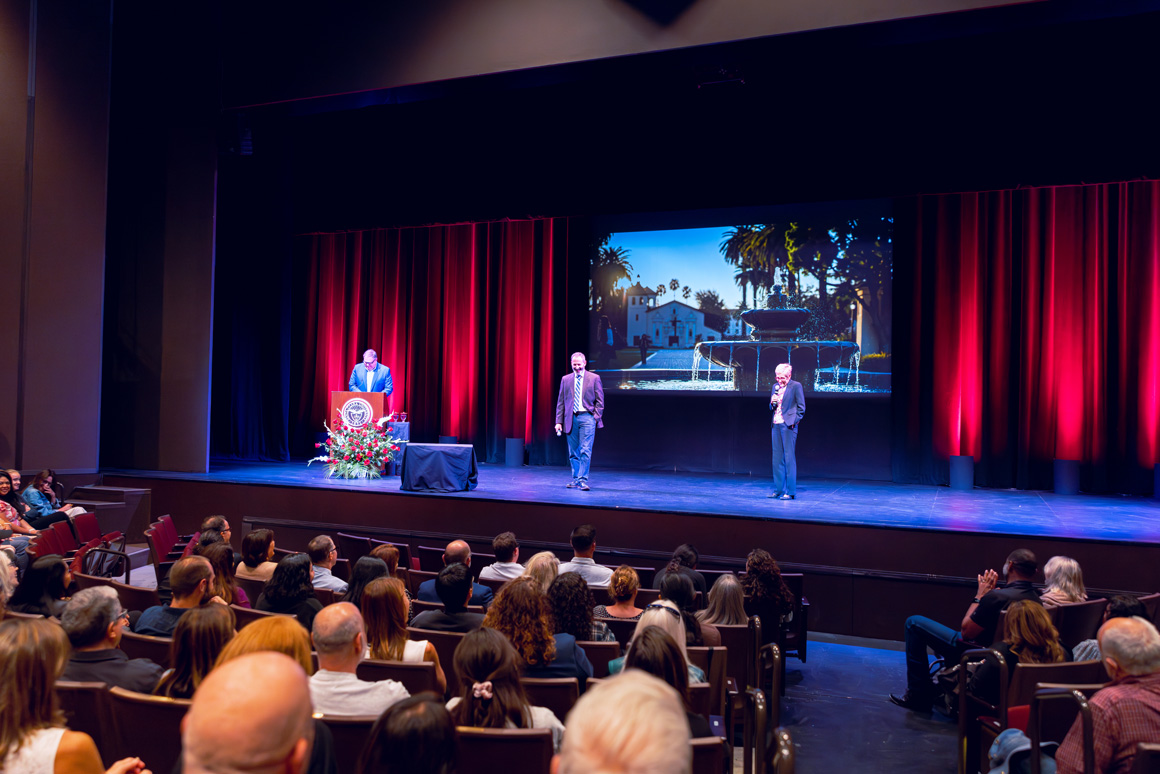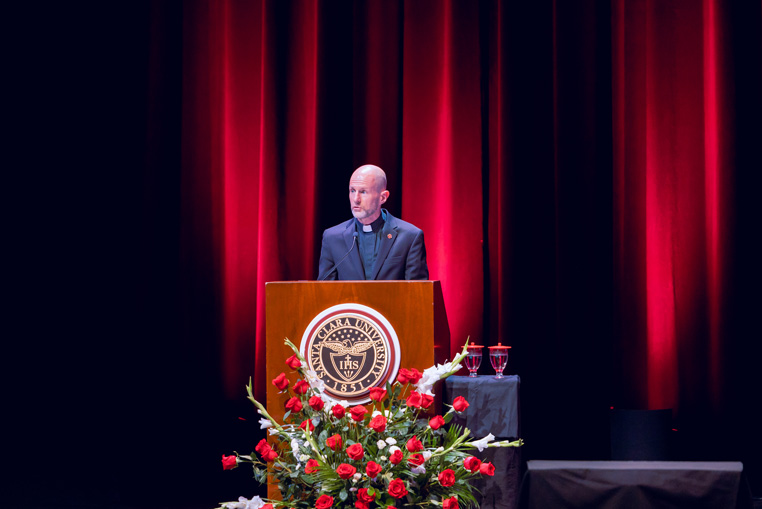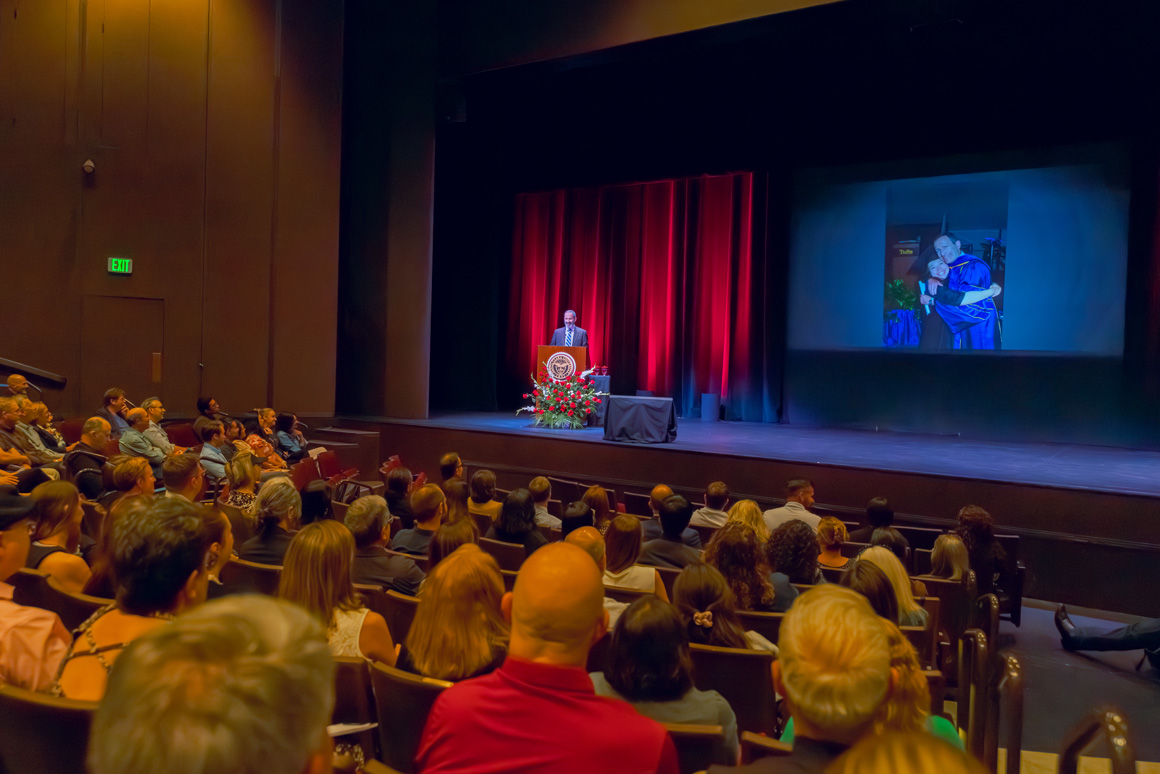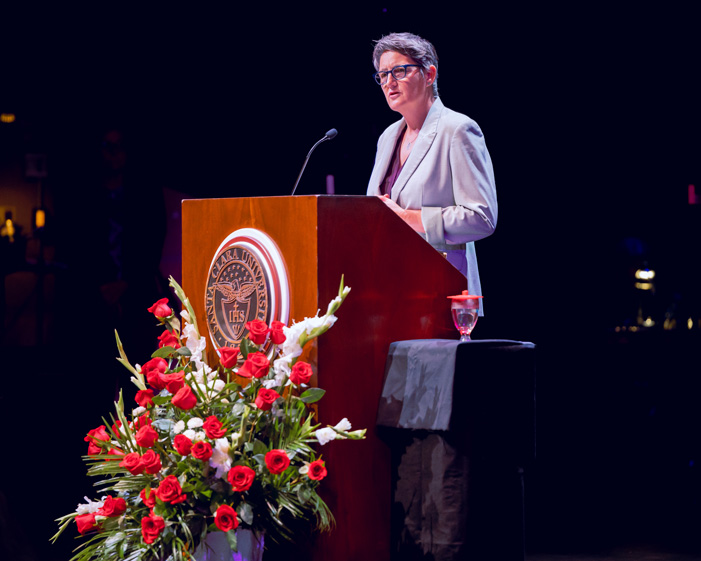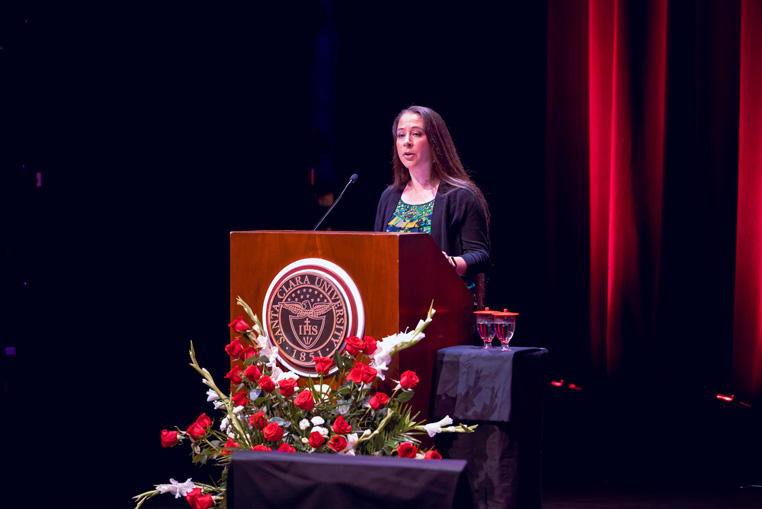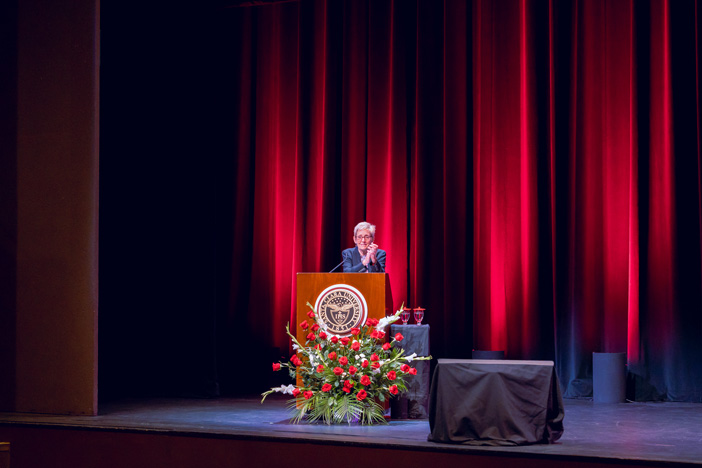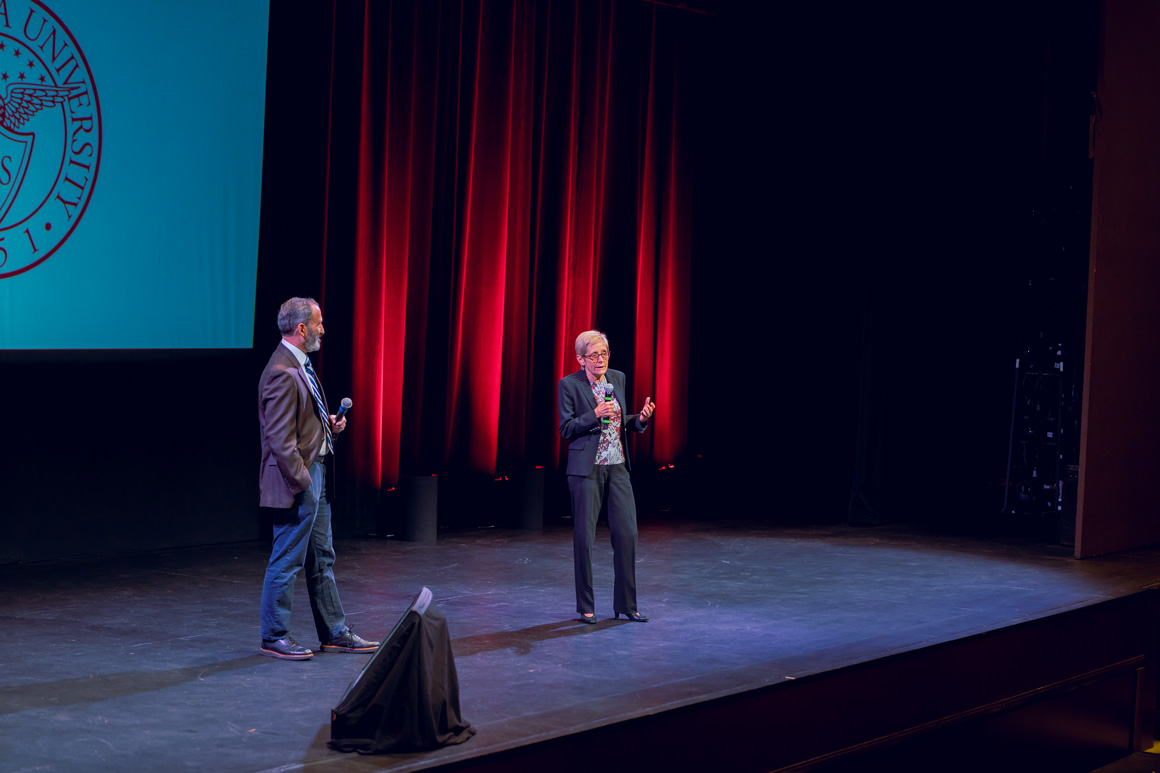Highlights from the September 17, 2024 Convocation as well as the full Convocation recording, and written remarks from President Julie Sullivan and Provost Jim Glaser.
Watch the Full Convocation
Convocation Remarks
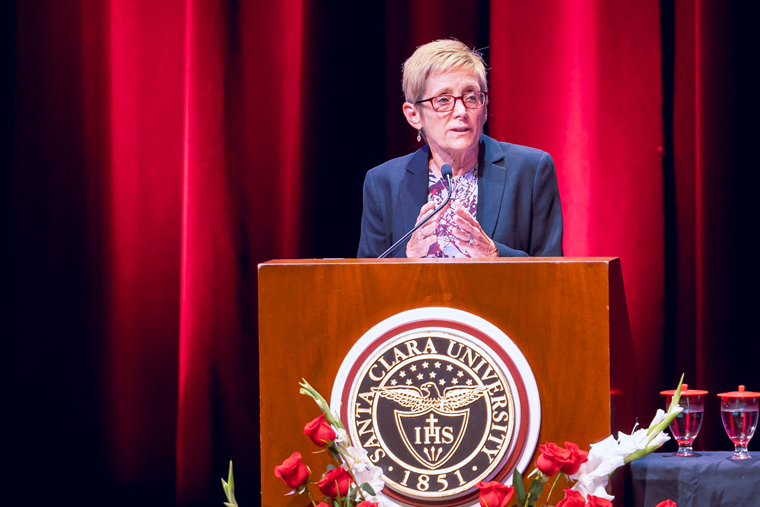
Julie Sullivan, President
Hello, Broncos! It is so wonderful to see so many of here in person! Our time together strengthens our community bonds. This is such an exciting time of year! I am beginning my 41st year in higher education, and I have never lost my enthusiasm and hope for what a new year will bring.
Actually, my biorhythms have revolved around the academic calendar for all of my life since age 5 when I started kindergarten. I went straight through school from there to finishing my Ph.D. and taking my first job as a university professor. Thus, this time has been the high point of my year almost all of my life!
Why? It’s a new beginning for what I love most, which is learning (something I never tire of and keeps me stimulated and hopefully young).
This time is also an inflection point – it’s a point where we look back at the previous year and celebrate our accomplishments and then look forward to the upcoming year with renewed energy, hopes, and dreams.
Soon, we will be off and running full speed ahead (and some of you already are). So, I want to spend the remainder of my remarks resting on this inflection point of the start of a new academic year, by first looking back and reflecting on what we, as a Bronco community, accomplished together, and then looking forward in anticipation of the upcoming year.
So, let’s begin by looking back to last year. In August, our Cabinet leaders (approximately 20 people – our provost, deans, vice presidents, and others) spent a day in rietreat together. Our facilitator asked us to list as many things as we could that we – meaning all of us – accomplished together this past year.
This is a visual of that work! Let’s sit with this a moment. There’s a lot here. And, this visual is not exhaustive. There are many other wonderful things that we accomplished together that are not included here. Now, give yourselves a hand!
I want to highlight a few things you see on the screen. First, Impact 2030 – I am so inspired by the roadmap we developed for ourselves in our bold strategic plan. And I want to highlight some of the great progress we are already making on our Strategic Priorities.
Opportunity for All Talented Students
This past year we recruited our first Posse cohort, and we are very excited to welcome them to campus this weekend. And we continued our work with other partners including American Talent Initiative (ATI), Association of Independent California Colleges and Universities (AICCU), transfer agreements and more.
As a result of these and other efforts, I am pleased to share some fabulous news. With our entering class of first year students this fall, we made tremendous progress towards increasing the socioeconomic diversity of our student body and in particular towards our Pell-eligible and first-generation student goals. The percent of Pell-eligible students rose from 12% last year to 17% this year. And the percent of first-generation students rose from 15% to 18%. With these increases, we achieved our 2030 goal (substantially ahead of schedule!) of 17% Pell students and now must work hard to maintain this huge achievement while continuing our progress towards our 2030 goal of 20% for first-generation students.
This is HUGE and reinforces our commitment to contributing to social mobility and strengthening democracy in our country by making our Jesuit education available to all talented students.
As a result of the Supreme Court ruling on race-conscious admissions, we were not—as you know—able to use race as a factor in our admissions or financial aid decisions this year. With this constraint in place, our percent of BIPOC students remained stable at 54% and our percent of historically underrepresented students remained stable at 32%. Our percentages of Latinx, two or more races, and white students each rose 1 percentage point. Our percentage of Black students fell 3.8 percentage points, and all other race and ethnicity groups changed less than 1 percentage point.
Thus, while we maintained overall racial and ethnic diversity of our incoming class, we have important work ahead to increase our Black students, and this will be a focus as we grow our student pathway programs and engagement with external communities. We want to become a school of choice for more Black students.
We also have more opportunity to increase Indigenous and Native American students, particularly given our growing relationships with our local tribes.
Positive strides with these two groups will help us meet our goal of ensuring they, and ALL of our students, flourish and experience a sense of belonging at Santa Clara.
Belonging for All Broncos
I am delighted with the diversity of the faculty and staff we hired this past year. Among our new tenure-track faculty, 46% are people of color, and among our new staff, 56% are people of color.
We also returned to in-person student orientation this past summer for the first time since 2019. These sessions have been extremely well attended and received robust positive feedback. As we stressed to the students and families attending, it was the beginning of their lifetime membership in our Bronco family, and a time to begin exploring this place we call home and getting to know fellow students and faculty and staff.
Our Gonzaga win in January of this year was an exciting display of the school spirit and strong community that is created with athletic success. Speaking of which, today is the first day of work for our new athletic director, Heather Owen. Heather, would you please stand? Now, no pressure Heather, but we would like to see a repeat this year. Please help me welcome Heather!
Reach on a Global Scale
Our Jesuit School of Theology created and began implementing their new strategic plan, En Camino, a pathway to becoming the leading Jesuit theologate in the world.
JST also launched the Global Theology Initiative (GTI), which met for the first time this past summer in Nairobi. The GTI is a global network of seven Jesuit theologates that will work together to reimagine their mission in the global Church and in the world.
The Miller Center went to Rwanda and Kenya to visit social entrepreneurs and our students who worked with them this summer.
The School of Law created a new partnership with IBERO, a university in Mexico City, and welcomed their first cohort of IBERO students this fall to their LL.M. program in U.S. law.
Solutions for the Universal Good
The School of Education and Counseling Psychology (ECP) graduated their first cohort of doctoral students with the doctor of education (EdD) in social justice leadership.
We launched the child and adolescent mental health concentration in the master’s of counseling psychology program.
We launched an interdisciplinary undergraduate minor in responsible AI.
Foundational Commitments
We reached agreement on a collective bargaining contract with our non-tenure stream faculty.
We successfully concluded our $1 billion capital campaign. Yes, one billion with a B! We are already experiencing the fruits of our donors’ generosity with beautiful new and renovated facilities and increased student scholarships.
In addition to our merit increases, we provided over $2 million to increase compensation for tenure and non-tenure stream faculty and an additional $1.2 million to support staff compensation and reclassifications.
We welcomed two marvelous leaders to our team (in addition to Heather)
- Jim Glaser our executive vice president and provost
- And, Father Matt Carnes, our vice president for mission and ministry
Welcome, Jim and Matt. The positive impact of your leadership is already being felt.
Looking Forward
These impressive and numerous achievements happened this past year as a result of our faculty’s and staff’s great effort and dedication. Tremendous work from people across this campus made these amazing things happen. Thank you!
Now, let’s look ahead. What’s on the horizon for this upcoming year? How can we continue this exciting work of becoming the leading Jesuit university in the world?
Opportunity for All Talented Students
I am excited to announce that this year as we recruit our incoming class for next fall, we will meet full demonstrated financial need for all incoming first-year students who are eligible for a California state grant. This is a tremendous effort to help more low- and middle-income families make our Santa Clara Jesuit education possible. For example, this new policy could benefit students from a family of five with an income of $140,000 or a family of three with an income of $120,000.
We also will meet full demonstrated need of all graduates of the Cristo Rey network of schools across the U.S.
Being able to boldly articulate these commitments attracts greater interest in Santa Clara, as more people see it as a possibility. These commitments are a first step towards our Big Hairy Audacious Goal, or BHAG, of meeting full financial need of all of our students.
Belonging for All Broncos
We will complete a remodel of the Multicultural Center (MCC) including adding bathrooms and a kitchen! This is a needed and important step forward in providing the kind of space our MCC students need to support their work advancing our vibrant multicultural community.
Reach on a Global Scale
We will complete our multi-faceted discernment of potentially moving the Jesuit School of Theology to the Santa Clara campus.
Solutions for the Universal Good
We will increase our support for faculty teaching and research, which Jim will say more about in a moment. We also will plan for the launch of our first cross-school graduate program, a master’s in social entrepreneurship and non-profit management, offered by the School of Education and Counseling Psychology and the Leavey School of Business.
Foundational Commitments
We will complete the staff total-rewards external review and implement the first phase of the action plan, which will strengthen our staff compensation structure and market competitiveness.
The Provost’s Office will continue to work with the Tenure-Track Faculty Salary & Rental Assistance Task Force to bolster support for compensation and housing.
We will complete our first iteration of the University’s five-year budget plan, enabling us to look into the future and plan for our strategic priorities.
This is just a brief sampling. We will make substantial progress on many, many other important goals and initiatives this year, and you will be able to follow this progress throughout the year with a new dashboard of metrics that will be available next month on the Impact 2030 website.
I thank you in advance for the significant contributions each of you will make towards our progress on Impact 2030 this year.
Our Environment
Of course, while we are very excited about this important work ahead, we know that we will be doing it against a global backdrop of tremendous geopolitical conflict and human suffering in our world. We come together in the midst of wars and the suffering that war brings; in the midst of humanitarian crises that place the innocent in peril; in the midst of increasing authoritarian rule and the corresponding restrictions of rights and freedoms; and in the midst of consequential elections being held in our own country and for nearly half of the world’s population. And we know that many in our community are experiencing trauma and high levels of personal anxiety, anger, and fear over these events.
Yet, against such a tumultuous backdrop, there is hope. The commitment to building a hope-filled future is at the center of our Jesuit roots. There is hope for peace; there is hope for democracy; there is hope for rebuilding; there is hope for opportunity; and there is hope for human kindness and support.
We must keep our hope, and the faith that supports it, alive. And, we must keep our Santa Clara community grounded in our Jesuit educational mission and values and ensure we are genuinely accompanying one another with understanding, respect, and empathy.
First, we must stay grounded in our educational mission as a university. A university is a cherished space for unfettered intellectual inquiry. It is a space that welcomes and is enrichened by all perspectives and lived experiences. It is a space where we critically examine, debate, and dialogue across differences. It is a space where all voices can be heard.
A university is not a political entity. Thus, it does not take a position on political candidates or political policies, unless the policy directly impacts the university’s educational mission or its operations.
Our university community is purposefully made up of a heterogeneous constituency. Our responsibility is to make room for policies and issues to be debated and not to silence any positions.
One special resource Santa Clara University has in doing this is our Jesuit, Catholic tradition and the values it brings to authentic, constructive dialogue. Pope Francis, in his encyclical Fratelli Tutti, called us to become a “culture of encounter.” He believes that we best discover the common good when we engage with one another. He sees listening — truly listening, with openness and cherishing of the other and with a sense of their infinite dignity, equal to our own — as the foundation for dialogue. Most importantly, he extols “the ability to respect the other’s point of view and to admit that it may include legitimate convictions and concerns” (FT, 203).
This is, of course, an embodiment of what St. Ignatius called the “Presupposition.” He encouraged us to interpret the words of others in their best sense, and to seek to understand the meaning and reasons behind them. As a Jesuit university, we strive to assume good intentions and to give others the space and grace to honestly express themselves, and for all of us to learn from one another, evolve in our thinking, and perhaps grow closer together. And even when we don’t come to closer agreement, we hold the other in respect for our shared humanity.
And at Santa Clara, this has an even deeper resonance and more meaningful possibility and responsibility, because this space is our home. It is not the public square. It is a home where we personally know one another and where we care for one another with compassion, kindness, and empathy. It is a home where we seek to understand the different perspectives, fears, faiths, and lived experiences of others who share our home—not to change our own views, necessarily, but to grow in our understanding of those who share our home.
So, at Santa Clara we have a unique mandate that gives us a special, even sacred, responsibility.
We are committed to protecting freedom of speech and expression, as long as it does not harass, intimidate, threaten, or discriminate. These protections are a bedrock of what it means to be a university. And as a Jesuit, Catholic university, we seek to hold ourselves to a higher standard, striving to express ourselves openly and freely while at the same time upholding our community values of respect, kindness, empathy, and understanding.
Programs and Resources
There will be many events and activities happening this year to help us stay grounded in our educational mission and our values. For example, here is a partial listing of campus offerings.
These programs represent the work of multiple departments across campus working alone, and in many cases together, to create meaningful and impactful programming to support our community through this challenging moment in time:
- Navigating Political Tensions at Work (HR)
- Upholding Democratic Values Forums (School of Law)
- Resource Guide: Israel-Palestine Conflict (University Library)
- Panels, Dialogue, Interfaith Resources (JST and Mission and Ministry)
- Restorative Justice Trainings (School of Law and Student Life)
- Microgrant Program for Educational Activities (Inclusive Excellence - IE)
- CAPS Workshops (Counseling & Psychological Services)
- Student Clubs (MCC/OML/IE & Student Life)
- USA Facts Nonpartisan Civic Initiative (Finance & Administration)
- Election Support & Voter Registration Programming (IE and Student Life)
- Community Conversations (IE, Mission & Ministry, HR)
- Democracy Series (IE)
In Closing
This academic year presents a renewed sense of hope and opportunity. I would like to conclude by expressing my joyful excitement for this year and by expressing my immense confidence in and gratitude for this community – our Bronco family! Thank you!
I am now pleased to invite Executive Vice President and Provost Jim Glaser, who has already become a valued colleague and good friend, to share remarks. These will be followed by your questions.
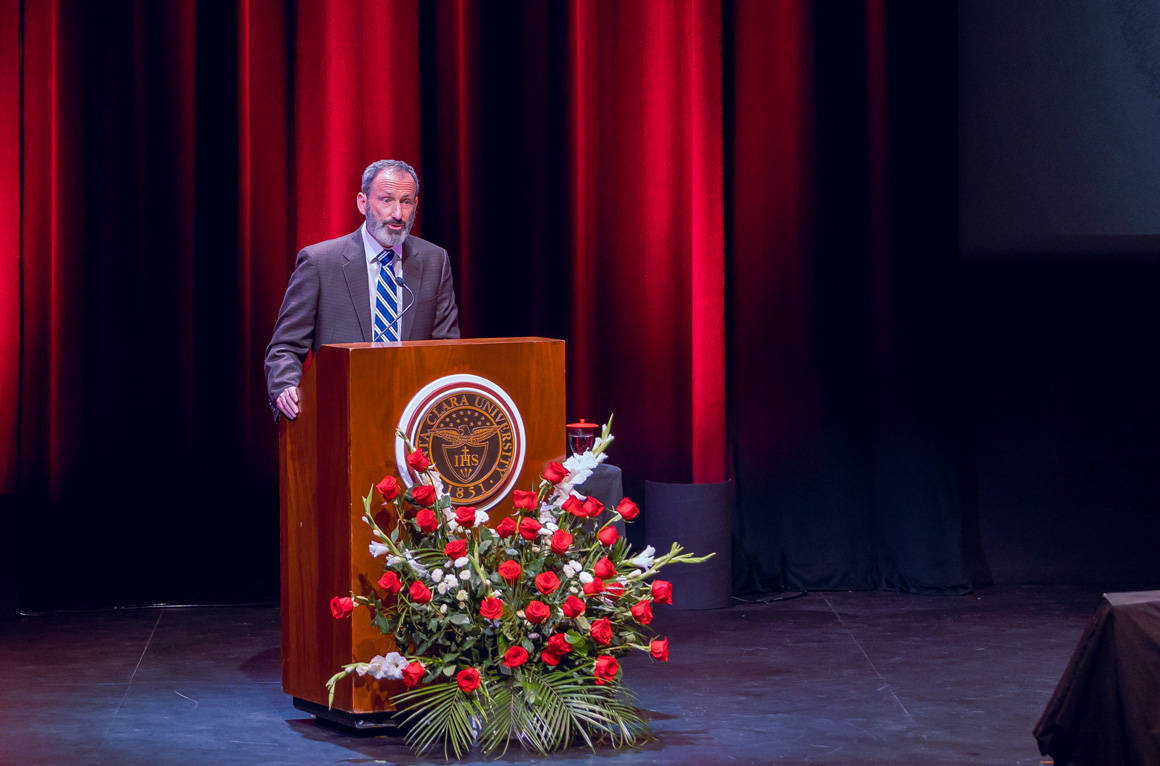
Jim Glaser, Provost and Executive Vice President
Thank you for introduction, Julie. I did spend one third of a century at Tufts. I knew everyone and everything there. I knew how everything worked. And I had many good times there. I hosted the graduations of both of my kids. I had a lot of fun in the job. I challenged my colleague, who was the dean of engineering, to a contest. The wager was over which school would raise the most money for a holiday charity drive, and the loser had to wear the ugliest Christmas sweater ever. As you can see here, I lost. I was able to travel all over the world: China, Western Europe, Turkey, India. And in 2017, I went to Russia.
So it’s really quite bracing to change after all that time. Change isn’t easy but it is exciting.
Here at Santa Clara, it’s an entirely new ballgame. But I’ve been welcomed so warmly here – by faculty and by many extraordinary staff. And there is a strong spirit of colleagueship among the leadership. I feel a part of this place already.
Shall I offer my first impressions of Santa Clara? It’s a glorious place. Its physical beauty is striking. The infrastructure is excellent – something not to be taken for granted. The Jesuit spirit is so generous and open. It guides but doesn’t suffocate. Of course, I’m going to have much to learn about the Ignatian philosophy, but I’m very ready to do that. And the university has very admirably embraced its history, acknowledging it’s complexity, even the injustices of the past, and properly celebrated its value to generations of students. What a blessing to be here.
I also think that there is also a lot for us to do here. We can’t just stand still. We have to seek continual improvement and growth, not just to say that we’re getting better, but because we have to prepare for the future. We have to stay a step ahead of changes – political changes, technological changes, demographic changes – that will affect our enterprise.
We want to unleash our faculty to be even more effective as knowledge creators and change agents, and, with that, improve the university’s reputation as a place of great knowledge creation and a place that makes our world more just, sustainable, and peaceful.
We want to take advantage of the great asset that is our location in Silicon Valley. We want to improve our ability to educate students, to create transformative experiences – both inside the classroom and outside it. And that requires more than faculty. It is dedicated, talented staff, working in the schools and the college and the centers, in the library, the residence halls, the Inclusive Excellence division, the Dramann Advising Center, and elsewhere who are so integral to doing this well.
So what are the academic leadership perspectives that I bring? Let me articulate a few of them.
Perspective #1: Change comes best when the ideas come organically from the community. I think about this as a political scientist – watching and studying politics and making social scientific arguments about how to persuade effectively and how to bring about change. Fortunately, we do have some well-defined goals for our university. We’ve just been through a rigorous strategic planning process – Impact 2030 – to identify our collective aspirations. I wasn’t here to participate in that process, but I’m ready to embrace the goals, strategies, and recommendations that are articulated in it.
Can we create a first-tier teaching center, an aspiration of Impact 2030? Absolutely – and I’m here to tell you right now, that a teaching center is in the works – we are going to create one, and, in a way informed by faculty and staff across the schools.
Can we grow our global opportunities and build new degree programs across our first-class schools? For sure – though in my opinion, we have to explore whether our quarter system is holding those aspirations back and we should discern whether we should become a semester-based university. That is a conversation I personally look forward to having with you.
Can we “position Santa Clara as a climate positive university?” I’ve already met some of the creative and ambitious environmental studies faculty who are leading the way and the superb leadership of the sustainability office, and I have some nascent ideas about how to leverage what they are doing – in the South Bay and nationally, with our peer Jesuit institutions.
I realize these aren’t always easy things to accomplish. They require resources and they sometimes require some bureaucracy-busting, which I am here to do. When the goals come organically from our community, and change is needed, we need to remove barriers, and make our administrative apparatus work to institutionalize the change. That isn't easy, I know, but it's critically important to do.
Perspective #2: Universities have to be open places. As President Sullivan has said so well, universities are “cherished spaces” that hold many different ideas, purposefully so. I agree. The national conversation about freedom of expression is happening in a challenging moment. You know, some years ago, I spotted a little item in the newspaper “Surprise expected.” Wait: If it’s expected, can it really be a surprise? Well, no. But the point is that we don’t know exactly what is coming, but we know that something is coming. And we should understand and articulate our general principles about freedom of expression before things happen.
The most important principle is that we must have broad tolerance for ideas, even ideas we may not like. There are, in my view, limits to free speech, but the boundaries are way out there – especially at a university. Ideas are currency on a college campus. We have to cultivate an environment where they aren’t suppressed. Now, we can’t guarantee that all ideas will be greeted with equal enthusiasm. People are free to express bad or unpopular ideas too and there is a right for people to respond negatively to them, but that’s what you get with free expression.
We also have a special responsibility as educators to create programming that allows students and our entire community to articulate their ideas, to learn from each other, and to engage different points of view. President Sullivan has spoken eloquently about how our Jesuit educational mission and values can provide valuable guidance. And, our faculty have a very important role to play in making sure we create an appropriate learning environment that is respectful and supportive of the views and beliefs of all our students. I really like how the law school, the Inclusive Excellence division, the Division of Mission and Ministry, and various other units around campus are sponsoring community conversations. These events include students. Students shouldn’t just be passive observers in these settings. They should be participants. And, these events create opportunities for us to model for our students how it can work. I’m looking forward to a semester of engagement.
Perspective #3: Our North Star should be excellence. This manifests itself in various ways. When evaluating faculty research and scholarship, it means that our processes should reward excellence. But how do we know what is excellent as we evaluate faculty research and scholarship? We look to the evaluations of peers in the field. Truth be told, as a consumer of these evaluations, I don’t always know the nouns and verbs in tenure and promotion letters, but I do understand the adjectives. And, I care a lot about what people write about our faculty’s work and its impact.
I also want to be transparent here that peer review is the gold standard. Rigorous, blind review gives us confidence in the quality of scholarship, and that is what we will be looking for. It also is the case that peer review improves the intellectual product. I know. It’s happened to me where the reviews have sharpened my argument, made me find better evidence, led me to give up some cherished but flawed idea.
All that said, we also care deeply about the teacher-scholar model and about excellence in teaching and mentoring. I had a fantastic conversation with a collection of faculty in Varsi Hall last week. We talked about the assessment of student learning and the importance of evaluating effectiveness of teaching through the lens of learning. That’s a sea-change from when I was in graduate school. I had a great experience in graduate school, but we never ever talked about how students learn, about how to teach to different learning styles, or how to measure what we were doing in the classroom. That’s been an enormous change in how we do things and it should inform how we think about what we are doing here.
I hope this gives you some sense of some of the ideas I bring to my position here. I’m so looking forward to working together. I feel so lucky to be here – working with an inspirational president, an amazing team of leaders, a first-class faculty and a very dedicated collection of staff to meet our purpose, so informed by the Jesuit ethos. To create knowledge and to educate both inside and outside the classroom the talented students we have here at Santa Clara University. Thank you.
